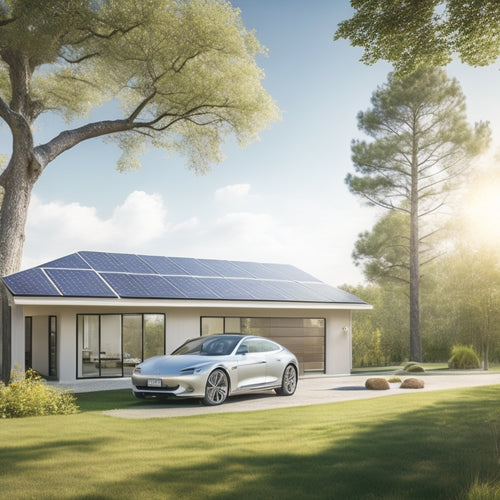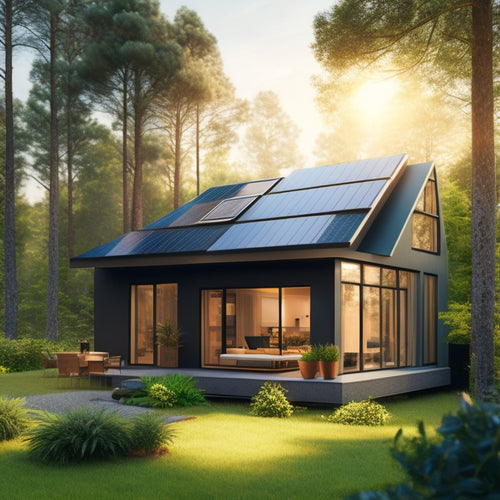
What You Need to Know Before Buying a Rooftop Solar System
Share
Before investing in a rooftop solar system, you'll want to assess your energy needs by reviewing past utility bills and analyzing your usage patterns. It's also essential to evaluate your roof's condition, ensuring it can support the weight of the solar panels. In addition, you'll need to choose the right solar panels, inverters, and mounting options that fit your energy goals and budget. Moreover, research local incentives and rebates, and consider installation and maintenance costs. By understanding these factors, you'll be better equipped to make an informed decision that maximizes your system's performance and return on investment, and there's even more to investigate when it comes to getting the most out of your solar system.
Key Takeaways
- Review past utility bills to understand energy consumption and identify opportunities for cost savings with a rooftop solar system.
- Ensure your roof is suitable for solar installation by evaluating its age, condition, and structural integrity to support panel weight.
- Choose high-efficiency solar panels with a good warranty, and consider factors like durability, temperature coefficient, and certifications.
- Research local and federal incentives, such as tax credits and rebates, to reduce upfront costs and optimize your return on investment.
- Consider maintenance costs and requirements, including regular cleaning and inspections, to ensure optimal system performance and longevity.
Understanding Your Energy Needs
Get a handle on your energy consumption before investing in a rooftop solar system. You need to understand your energy needs to determine the right size of the system and maximize its benefits.
Start by reviewing your past utility bills to identify your average energy consumption in kilowatt-hours (kWh). This will help you understand your energy usage patterns and identify areas for improvement.
Analyze your energy consumption during peak and off-peak hours, as well as during different seasons. This information will help you determine the ideal system size and configuration.
You should also consider your utility rates and how they might affect your savings. Are you on a time-of-use (TOU) rate plan, or do you have a tiered rate structure?
Understanding your energy consumption and utility rates will help you make informed decisions when selecting a rooftop solar system. By doing your homework, you'll be able to optimize your system's performance and enjoy the maximum return on your investment.
Assessing Your Roof's Condition
When evaluating your roof's condition, you'll want to take into account its age and history, as an older roof may not be suitable for a solar system.
You'll also need to check the structural integrity of your roof to guarantee it can support the added weight of the solar panels.
A thorough inspection will help you identify any potential issues that could affect the performance and longevity of your rooftop solar system.
Roof Age and History
Your roof's age and history play a crucial role in determining its suitability for a rooftop solar system. The roof's age affects its condition, and an older roof may not be suitable for solar panels. You should evaluate the roof's age, material, and maintenance history before installing a solar system.
| Roof Age | Roof Condition | Suitability for Solar |
|---|---|---|
| < 10 years | Likely in good condition | Suitable for solar installation |
| 10-20 years | May have some wear and tear | Review roof condition before installation |
| > 20 years | Likely nearing end of life | May not be suitable for solar installation |
| Unknown | Unknown | Inspect roof before installation |
When examining your roof's history, check if it has undergone repairs or replacements. Also, review your roof warranties to confirm you're not voiding any existing warranties by installing solar panels. Installation timelines may be affected by the need for roof repairs or replacement before installing the solar system. It's important to evaluate these factors to guarantee a successful and long-lasting solar installation.
Structural Integrity Check
Regularly, homeowners overlook a vital aspect of rooftop solar system installation: evaluating their roof's structural integrity.
You can't assume your roof is ready for solar panels without examining its condition. A structural integrity check is essential to guarantee your roof can support the weight of the solar system.
-
Your roof's age, material, and condition will impact its load capacity evaluation.
-
Structural modifications may be necessary to guarantee your roof can handle the added weight of solar panels.
-
A thorough inspection can identify potential issues, such as rotten wood, damaged trusses, or weak spots.
- A professional evaluation can provide a detailed report outlining any necessary repairs or upgrades before installing your solar system.
Choosing the Right Solar Panels
Several key factors come into play when selecting the ideal solar panels for your rooftop system.
You'll want to take into account the solar panel efficiency, which is measured by its ability to convert sunlight into electrical energy. Look for panels with high efficiency ratings, typically above 20%, to maximize your energy output.
Another important aspect is the panel warranty, which typically ranges from 25 to 30 years. A longer warranty period provides assurance that the manufacturer stands behind their product's quality and performance.
You should also take into account the type of solar panels: monocrystalline, polycrystalline, or thin-film. Each has its advantages and disadvantages, so it's vital to research and understand their differences.
Additionally, think about the panel's durability, temperature coefficient, and certifications, such as UL or IEC.
Inverters and Mounting Options
You're now focusing on the vital components that convert sunlight into usable electricity and securely fasten your solar panels to your roof.
You'll need to decide between string inverters, microinverters, and power optimizers, each with their own strengths and weaknesses.
Additionally, you'll choose from various mounting systems, including rail-based, rail-less, and shared-rail options, which impact the installation's overall cost and efficiency.
Inverter Types Compared
When selecting a rooftop solar system, choosing the right inverter type is essential as it directly impacts the efficiency and reliability of your solar panel array.
You'll need to evaluate factors such as inverter efficiency, compatibility, and warranty when making your decision.
Here are the key inverter types to evaluate:
-
String Inverter: Connects multiple solar panels in a series, offering high efficiency and cost-effectiveness, but can be affected by shading or panel mismatch.
-
Micro Inverter: Attached to each solar panel, providing individual panel optimization and monitoring, but at a higher upfront cost.
-
Power Optimizer: Combines the benefits of string and micro inverters, offering panel-level optimization and monitoring at a lower cost than micro inverters.
- Hybrid Inverter: Combines a solar inverter with a battery inverter, enabling energy storage and backup power during grid outages.
Each inverter type has its pros and cons, and your choice will depend on your specific needs and budget.
Be sure to research each option thoroughly and evaluate factors such as inverter installation, warranty, and maintenance requirements before making a decision.
Mounting System Options
Now that you've selected the right inverter type for your rooftop solar system, it's time to evaluate the mounting system options that will securely fasten your solar panels to your roof.
You'll need to decide between fixed mounts and adjustable mounts, each with its own benefits.
Fixed mounts are the most common type, offering a cost-effective solution. They're ideal for roofs with a consistent angle, as they're installed at a fixed tilt. This simplicity also makes them easier to install and maintain.
However, they may not be suitable for roofs with multiple angles or obstructions.
Adjustable mounts, on the other hand, provide more flexibility. They allow you to adjust the angle of your solar panels to optimize energy production throughout the year.
This is particularly useful for roofs with multiple angles or those that receive shade during certain times of the day. While they're more expensive, adjustable mounts can lead to higher energy yields and a faster return on investment.
Consider your roof's unique characteristics and energy goals to determine which mounting system is right for you.
Local Incentives and Rebates
In addition to federal tax credits, local incentives and rebates can greatly reduce the upfront cost of a rooftop solar system. As you consider investing in solar energy, it's crucial to investigate the local incentives available in your area. These incentives can vary widely depending on your location, but they can considerably impact the overall cost of your system.
Some local incentives to look out for include:
-
State tax credits: Many states offer additional tax credits for solar installations, which can be claimed in addition to federal tax credits.
-
Utility rebates: Your local utility company may offer rebates for solar installations, which can help offset the upfront cost.
-
Local government incentives: Some municipalities offer incentives, such as property tax exemptions or low-interest loans, to encourage the adoption of renewable energy.
- Non-profit organization incentives: Non-profit organizations, such as the Database of State Incentives for Renewables & Efficiency (DSIRE), provide resources and incentives for energy efficiency projects, including rooftop solar systems.
Installation and Maintenance Costs
Choosing a rooftop solar system involves more than just the upfront purchase price; it's important to evaluate the installation and maintenance costs that come with it. These costs can add up quickly, so it's vital to factor them into your overall budget.
Installation costs typically range from $2.50 to $3.50 per watt, depending on the complexity of the installation and the quality of the equipment. This means a standard 5-kilowatt system could cost between $12,500 and $17,500 to install.
When considering installation costs, you'll also want to think about the installation timeline. Most installations take several days to a few weeks to complete, depending on the size of the system and the number of installers.
Be sure to ask about financing options, as many solar companies offer financing plans or partnerships with lenders to help make the cost more manageable.
Additionally, consider the maintenance costs associated with your system, including regular cleaning and inspections. While these costs are typically minimal, they're still important to factor into your overall budget.
Frequently Asked Questions
Can I Install Solar Panels on a Metal or Clay Tile Roof?
You can install solar panels on a metal roof, but metal roof considerations like rust and corrosion require specialized mounting systems. Clay tile compatibility is also possible, but you'll need to verify the tile's structural integrity can support the added weight.
Do Solar Panels Work During a Power Outage?
You're wondering if solar panels work during a power outage. They don't, unless you have a battery storage system, which guarantees grid independence. Otherwise, your solar panel efficiency is tied to the grid, shutting down during outages for safety reasons.
Can I Add More Panels to My System Later?
You can add more panels to your system later, but you'll need to confirm system sizing and panel compatibility, considering factors like voltage, wattage, and connector type, to avoid compatibility issues and guarantee peak performance.
Will Solar Panels Affect My Roof's Warranty?
As you initiate this sustainable expedition, a question emerges like a cloud on the horizon: will solar panels affect your roof's warranty? Fortunately, most manufacturers honor warranties despite solar installations, but you'll need to evaluate roof warranty implications and installation considerations to guarantee a harmonious coexistence.
Can I Install Solar Panels on a Rented Property?
You're considering solar panels on a rented property, but you'll need to investigate renter options and negotiate with your landlord to include solar-friendly lease agreements, ensuring a mutually beneficial arrangement that works for both you and your landlord.
Conclusion
As you commence on the expedition to utilize the power of the sun, remember that buying a rooftop solar system is like maneuvering through a maze - it requires careful planning and attention to detail to reach the treasure at the end. By understanding your energy needs, evaluating your roof's condition, choosing the right solar panels, and considering inverters, mounting options, local incentives, and maintenance costs, you'll be well on your way to revealing the full potential of solar energy and reaping its rewards.
Related Posts
-

Why Invest in Solar Car Battery Chargers Online?
By investing in a solar car battery charger online, you're not only reducing your reliance on fossil fuels but also o...
-

What You Need to Know About Permits and Inspections
You need to navigate the complex landscape of permits and inspections to guarantee your project complies with local z...
-

Reduce Solar Panel Cost for Your Small Home
By evaluating your energy needs, choosing the right installer, and selecting cost-effective solar panel options, you ...


